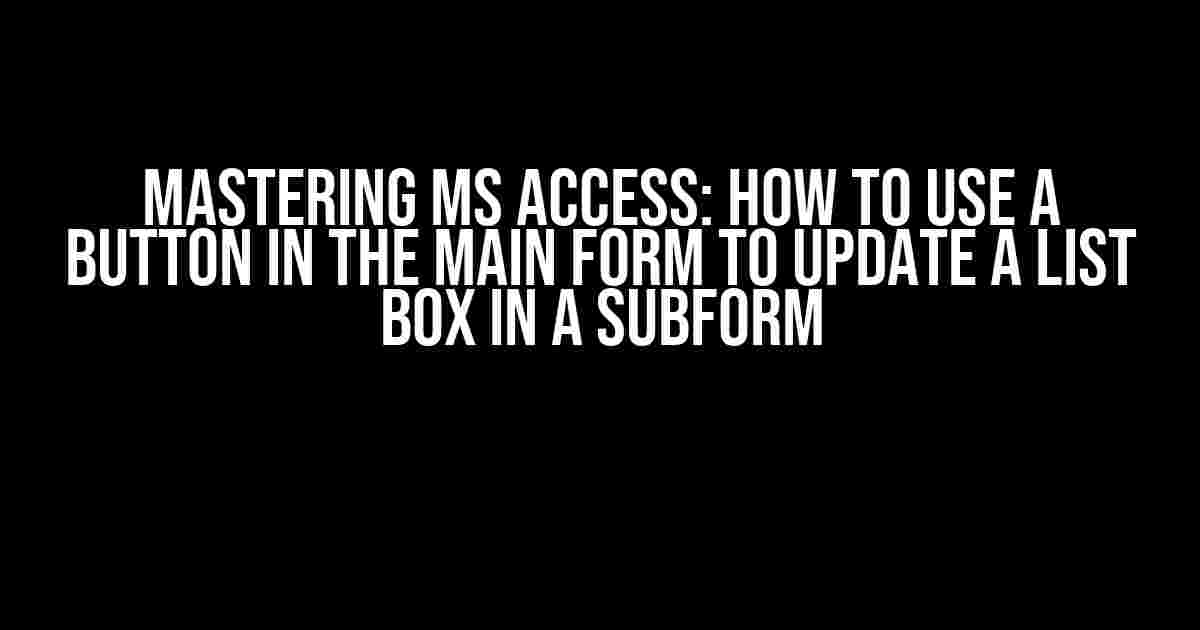Are you tired of manually updating your list box in a subform every time you need to make a change? Do you want to learn how to harness the power of MS Access to streamline your workflow? Look no further! In this comprehensive guide, we’ll show you how to use a button in the main form to update a list box in a subform, saving you time and increasing productivity.
Understanding the Basics of MS Access Forms
Before we dive into the tutorial, let’s quickly cover the basics of MS Access forms. A form is a visual representation of a table or query that allows users to interact with the data. In MS Access, you can create two types of forms: main forms and subforms.
Main Forms
A main form is a standalone form that displays data from a table or query. It’s typically used to display and edit data, and can contain controls such as text boxes, combo boxes, and buttons.
Subforms
A subform is a form that’s embedded within another form, known as the main form. Subforms are used to display related data, such as details about a master record. For example, if you have a main form that displays customer information, a subform could be used to display the customer’s order history.
Creating the Main Form and Subform
For this tutorial, we’ll assume you have a main form called frm_Main and a subform called frm_Sub. The main form will contain a button that, when clicked, will update a list box in the subform.
Note: If you don’t have a main form and subform set up, create them now by following these steps:
- Open your MS Access database and navigate to the
Createtab. - Click the
Formbutton in theFormsgroup. - Select the table or query you want to base your form on and click
OK. - Drag a
Buttoncontrol from theToolboxonto the form. - Right-click the button and select
Properties. In theOn Clickevent, enter the following code:[Event Procedure]. - Create a new form by repeating steps 2-5. This will be your subform.
- Add a
List Boxcontrol to the subform. - Save and close both forms.
Configuring the Button in the Main Form
Now that we have our main form and subform set up, let’s configure the button in the main form to update the list box in the subform.
Adding VBA Code to the Button
Open the main form in Design view by right-clicking it in the Navigation Pane and selecting Design View.
Double-click the button to open its Properties sheet. In the On Click event, click the [...] button to open the Visual Basic Editor.
Private Sub cmd_UpdateList_Click()
' Code to update the list box in the subform will go here
End Sub
Updating the List Box in the Subform
Now that we have our VBA code set up, let’s add the code to update the list box in the subform.
Private Sub cmd_UpdateList_Click()
Dim dbs As DAO.Database
Dim rs As DAO.Recordset
Dim frm As Form
Dim lst As Control
' Set the database and recordset objects
Set dbs = CurrentDb()
Set rs = dbs.OpenRecordset("YourTableOrQueryName", dbOpenDynaset)
' Set the form and list box objects
Set frm = Forms!frm_Main!frm_Sub.Form
Set lst = frm.Controls("YourListBoxName")
' Clear the list box
lst.RowSource = ""
' Loop through the recordset and add items to the list box
rs.MoveFirst
Do Until rs.EOF
lst.AddItem rs!YourFieldName
rs.MoveNext
Loop
' Clean up
rs.Close
Set rs = Nothing
Set dbs = Nothing
End Sub
Explanation of the Code
Here’s a breakdown of the code:
- We set the database and recordset objects using the
DAOlibrary. - We set the form and list box objects using the
Formscollection. - We clear the list box by setting its
RowSourceproperty to an empty string. - We loop through the recordset using a
Do Untilloop, adding each item to the list box using theAddItemmethod. - We clean up by closing the recordset and setting the objects to
Nothing.
Testing the Button
Save the VBA code and close the Visual Basic Editor. Switch to Form view by clicking the View button in the Home tab.
Click the button in the main form to update the list box in the subform. If everything is set up correctly, the list box should now display the updated data.
Troubleshooting Common Issues
If you encounter any issues, here are some common solutions:
| Issue | Solution |
|---|---|
| The button doesn’t update the list box | Check that the button’s On Click event is set to the correct VBA procedure. Also, ensure that the list box is properly configured and has the correct RowSource property. |
| The list box displays no data | Check that the recordset is properly configured and that the table or query has data. Also, ensure that the list box’s RowSource property is set to the correct table or query. |
| The button triggers an error | Check the VBA code for syntax errors and ensure that all objects are properly declared and set. Also, ensure that the button’s On Click event is set to the correct VBA procedure. |
Conclusion
In this comprehensive guide, we’ve shown you how to use a button in the main form to update a list box in a subform in MS Access. By following these steps, you’ll be able to streamline your workflow and increase productivity. Remember to troubleshoot common issues and customize the code to fit your specific needs.
With your newfound knowledge, you’re ready to take your MS Access skills to the next level! Remember to stay tuned for more tutorials and guides on how to master MS Access.
Happy Accessing!
Frequently Asked Question
Get ready to unlock the power of MS Access and elevate your database game!
Q: How do I create a button in my main form to update a list box in a subform?
A: To create a button that updates a list box in a subform, you’ll need to add a command button to your main form, and then set the On Click event to run a macro or VBA code that updates the list box. You can do this by going to the Form Design view, adding a command button, and then setting the On Click event to the macro or VBA code.
Q: What type of macro or VBA code do I need to write to update the list box?
A: You’ll need to write a macro or VBA code that uses the Requery method to update the list box. For example, you can use the following code: `Me.MySubform.Form.MyListBox.Requery`. This code will requery the list box and update it with the latest data.
Q: Can I update the list box based on a specific criteria or filter?
A: Yes, you can update the list box based on a specific criteria or filter. You can use the Filter property to set a filter for the list box, and then use the Requery method to update the list box. For example, you can use the following code: `Me.MySubform.Form.MyListBox.Filter = “MyField = ‘MyValue'”` and then `Me.MySubform.Form.MyListBox.Requery`.
Q: How do I ensure that the button only updates the list box and not the entire subform?
A: To ensure that the button only updates the list box and not the entire subform, you can use the `Me.MySubform.Form.MyListBox.Requery` code instead of `Me.MySubform.Requery`. This will only update the list box and not the entire subform.
Q: Can I use this method to update multiple list boxes in a subform?
A: Yes, you can use this method to update multiple list boxes in a subform. Simply repeat the process for each list box, using the same code but replacing the list box name with the name of the list box you want to update. For example, `Me.MySubform.Form.MyListBox1.Requery` and `Me.MySubform.Form.MyListBox2.Requery`.


